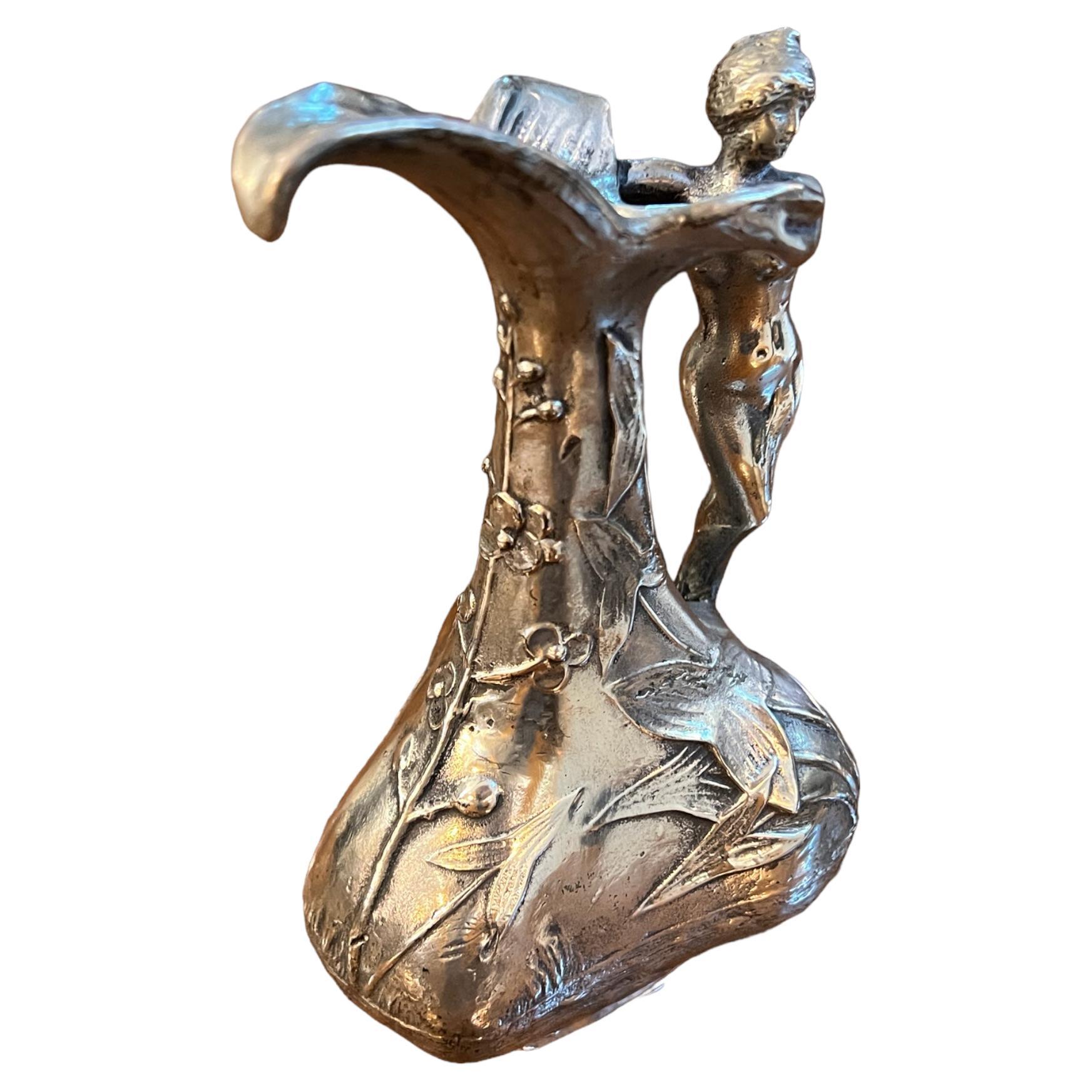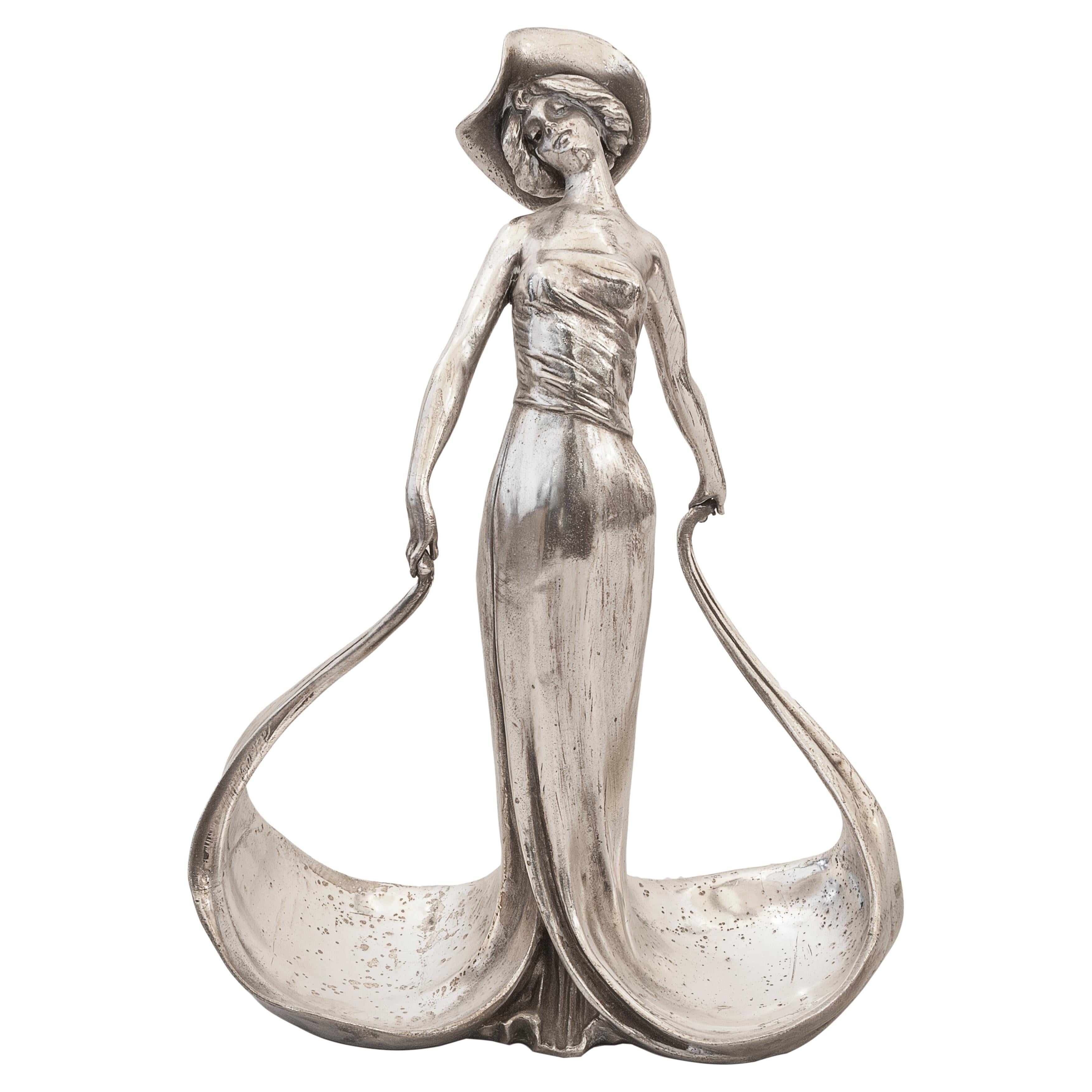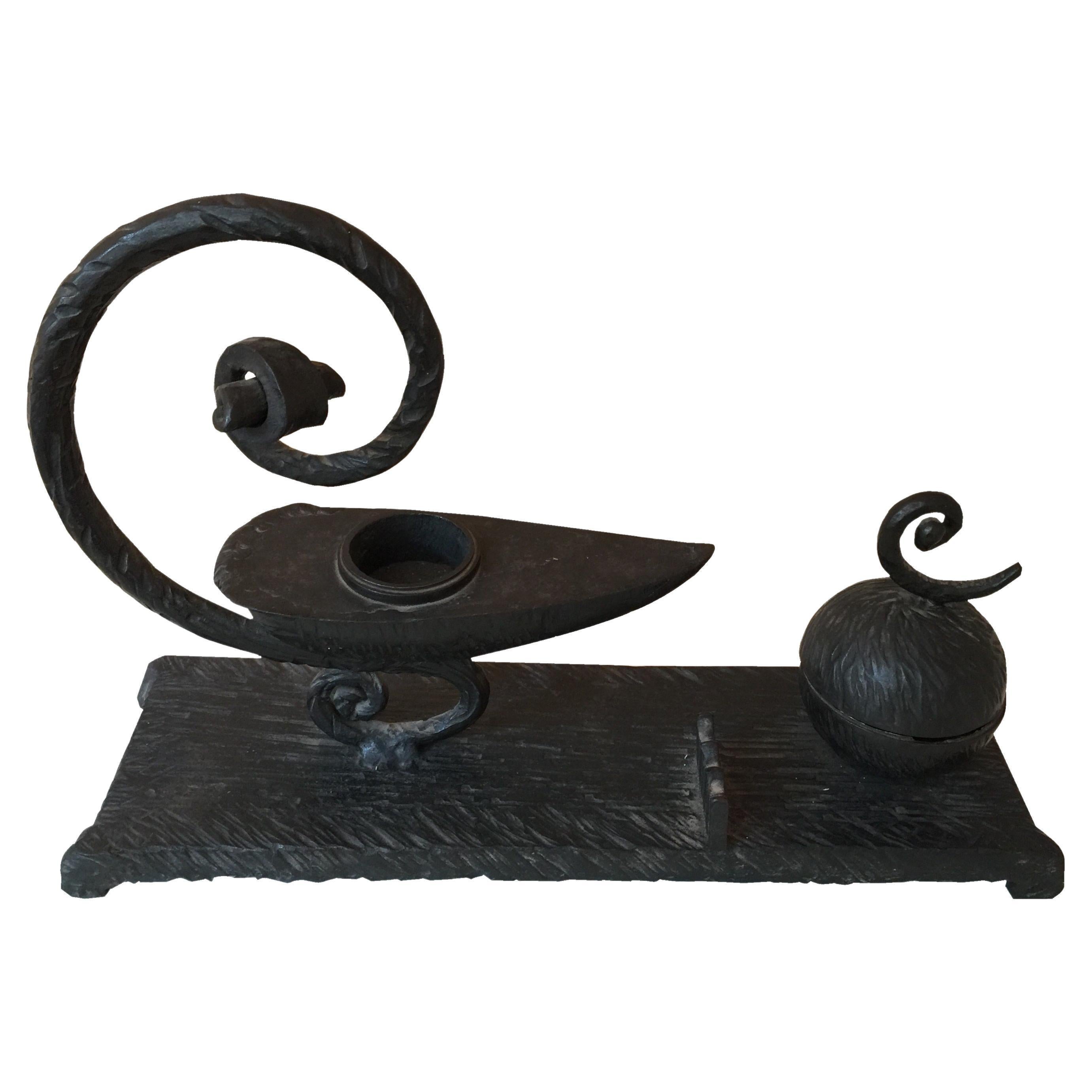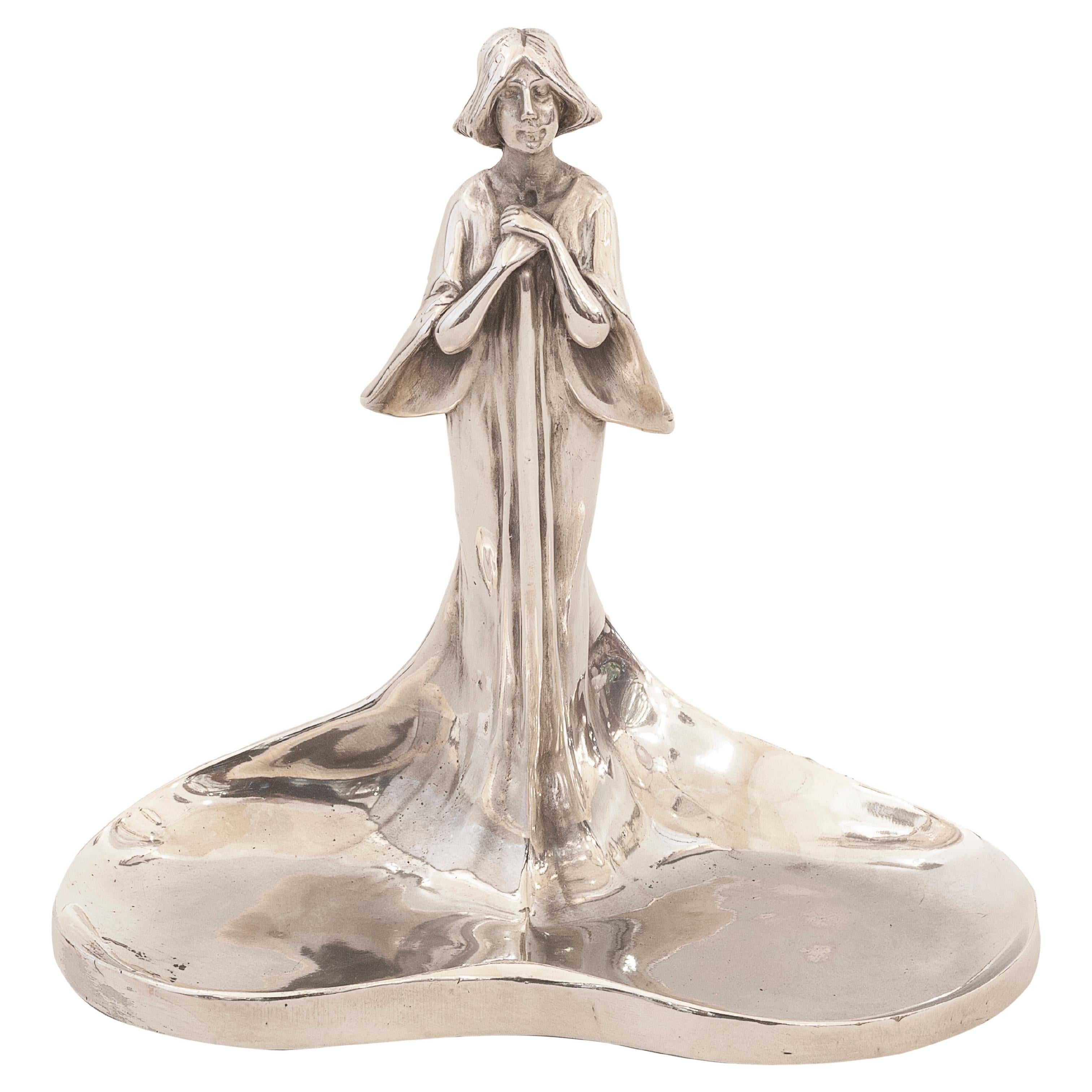Items Similar to Jar, Jugendstil, Art Nouveau, Liberty, 1900, Sign: Argentor
Video Loading
Want more images or videos?
Request additional images or videos from the seller
1 of 22
Jar, Jugendstil, Art Nouveau, Liberty, 1900, Sign: Argentor
About the Item
Material: Silver plated
We have specialized in the sale of Art Deco and Art Nouveau and Vintage styles since 1982. If you have any questions we are at your disposal.
Pushing the button that reads 'View All From Seller'. And you can see more objects to the style for sale.
Argentor wien (Austria)
he history of the company dates back to 1863, when CA Münchmeyer & Co. was founded. This was the owner of an electroplating factory that was built in 1894 on a narrow, long stretch of land between Kaiserstraße and Wimbergergasse in the 7th district of Vienna . CA Münchmeyer & Co. had Stagl Brodhag build a residential and administrative building at Kaiserstrasse 83, along with a six-storey courtyard wing. Branch factories existed in Berlin and Paris in the early 20th century, with branches in Vienna at Casa Piccola at Mariahilfer Strasse 1c in the 6th district and at Waitznergasse 14 in the 4th district of Budapest.
In 1902, the predecessor company CA Münchmeyer & Co. became the Argentor-Werke Rust & Hetzel. Over time, the Argentor-Werke became one of the most important metalware manufacturers of Viennese Art Nouveau . Not only silver cutlery , bowls , centerpieces, tea and coffee services were manufactured , but also home furnishings such as frames , clocks , electric lamps , vases and flower holders. Of particular importance were the so-called mount articles, which were mounted glasses with the frame manufactured by the Argentor works. A number of the glasses used came from the famous Art Nouveau glass company Joh. Loetz Witwe , with whom Argentor worked.
The company became very successful, producing thousands of models and exporting worldwide. A company publication from 1912 mentions about 9000 articles of goods. In 1911 there were branches in Budapest and Brno . Customers included not only the upper classes and the aristocracy, but also the imperial court. For their merits, the owners Georg Ferdinand Rust and Adolf Wilhelm Hetzel were awarded the title of kuk purveyor to the court .
Despite all the turmoil, the Argentor-Werke survived the First World War , but with increasing financial losses. It produced some movements during World War II , but ceased to exist at the latest in 1970. Exquisite works from the Argentor factories fetch high prices at auction today.
Why are there so many antiques in Argentina?
In the 1880 – 1940 there was a grate wave of immigration encouraged by the periods of war that were taking place.
1st World War took place between 1914 and 1918
2nd World War took place between 1939 and 1945
The immigrants options were New York or Buenos Aires. Tickets were cheap and in Buenos Aires they were welcomed with open arms, as it was a country where everything was still to be done.
Argentina was the country of new opportunities, labour was needed and religious freedom was assured, in many cases the of the family travel first until they were settled and then the rest of the family members join them.
In the immigrant museum “Ellis Island Immigrant Building” in New York you can se the promotional posters of the boats that would take them to a new life.
Between the years 1895 and 1896, Argentina had the highest DGP (gross domestic product) per capita in the world according to the Maddison Historical Statistics index, this situation arose due to the large amount of food being exported to European countries, which were at war.
The Argentinean ships left the port of Buenos Aires with food, but they returned with furniture, clothes and construction elements, (it´s common to see this the old buildings of the historic neighbourhood of San Telmo, the beams with the inscription “Made in England)”, as well as many markets that were built in Buenos Aires, such us the San Telmo Market, whose structure was brought by ship and afterwards assembled in 900 Defensa Street.
With the great influence of European immigrants living in the country, the children of the upper classes travelled to study in France, resulting in the inauguration of “La Maison Argentinienne”, on 27th of June 1928, in the international city of Paris, which hosted many Argentinians that were studying in Frace.
It´s the fourth house to be built after France, Canada and Belgium, being the first Spanish-speaking one. Still in place today (17 Bd Jourdan, 75014, Paris, France). Many of the children of these wealthy families who attended international art exhibitions, museums and art courses abroad, took a keen interest in the European style. This is why Buenos Aires was at the time referred as “The Paris of South America”.
Between the years 1890 and 1920 more than a hundred Palaces were built on Alvear Avenue the most exclusive avenue in Buenos Aires. Today some of these palaces have been transformed into museums, hotels and embassies.
In the year 1936, the Kavanagh building was inaugurated, it was the tallest reinforced concrete building in South America.
During 1994 the American Society of Civil Engineers distinguished it as an “international engineering milestone”, and it´s now considered a World Heritage of Modern Architecture.
At the time was common to hire foreign architects such as Le Corbusier, who visited Buenos Aires/Argentina in 1929 and in 1948 he drew up the blueprints for a house built in La Plata City (which was declared a World Heritage Site).
In 1947, the Hungarian architect Marcelo Breuer designed “Parador Ariston” in the seaside city of Mar del Plata. After an Argentinean student at Harvard University convinced him to come to Argentina. He worked on an urban development project in the Casa Amarilla, area of La Boca.
The Ukrainian architect, Vladimiro Acosta, arrives in Argentina in 1928 and worked as an architect until que moved to Brazil.
Antonio Bonet, a Spanish architect who worked with Le Corbusier in Paris, arrives in Argentina in 1937, where he carried out several architectural works and in 1938 designs the well-known BFK chair.
Andres Kálnay, of Hungarian origin, made around 120 architectural masterpieces, among which the former Munich brewery stands out, he even made the furniture’s design.
The German architect, Walter Gropius, director of the Bauhaus, lived in Argentina, where he wrote articles for “Sur” magazine and founded in Buenos Aires, an architectural firm with Franz Möller, who was also an architect, where he built two houses.
At the same time several famous designers decided to immigrate to Argentina, among them we can find the well-known French designer, Jean-Michel Frank, who arrived in the country in 1940 and also worked for the Rockefeller family.
Special pieces were made, which were sold exclusively in the country, such as the well-known German company “WMF”, who sold their products by catalogue, which were chosen by the ladies of High Society in the list of wedding gifts, as well as the pieces designed by Christofle.
The Swiss sculptor Alberto Giacometti, made special pieces for Argentinean mansions.
In 1904 the first Jansen branch outside Paris was established in Buenos Aires, as the Argentinean clientele demanded a large amount of furniture, from the end of the 19th century to the mid-20th century.
In 1970, the brand Rigolleau Argentina made pieces authorised by Lalique.
The brands Maple and Thompson also set up shop in the country.
The French plastic artist, Marcel Duchamp moved to Argentina in 1918-1919.
Glass signed Gallé, Charder, Leverre, Schneider, Muller and other French firms. They were bought in flower shops and were given to ladies with beautiful floral arrangements.
Some furniture manufacturers travelled to international fairs and bough the patterns to produce the furniture in Argentina, such as the furniture firm Englander and Bonta, who bought the patterns ins Italy.
It is worth mentioning that in Argentina we have the largest Community of Italians outside of Italy, as it is estimated that 70 percent of the inhabitants have at least one Italian descendant, followed by Spanish immigrants.
The most Important furniture stores in Argentina:
Comte is founded in 1934 (under the direct management of Jean Michel Frank in 1940).
Nordiska (Swedish company established in 1934).
Churba in 1960, a company that brought foreign designers to present their furniture in the country:
Denmark: (Arne Jacobsen, Finn Juhl, Bender Madsen, Ejner Larsen, Poul Kjaerholm, Hans Wegner)
Sweden: (Hans Agne Jakobsson, Gustavsberg)
United States: (Herman Miller)
Finland: (Lisa Johansson, Folke Arstrom, Tapio Wirkkala, Alvar Aalto, Timo Sarpaneva)
Swedish Factory: (Orrefors)
Italy: (Littala, Vico Magistretti, Emma Gismondi, Gae Aulenti, Angelo Mangiarotti, Elio Martinelli, Gianna Celada, Angelo Mangiarotti, Mario Bellini, Carlo Scarpa)
Finland: (Olivia Toikka)
Plata Lappas (Lappas Silver): a goldsmith shop founded in 1887 in Argentina by Alcibiades Lappas of Greek origin.
In 2019, in Argentina took place “the Art Deco world congress”, in which we participated as hosts invited by Geo Darder, founder of the Copperbridge – Foundation, in which prominent people from all over the world attended to learn about Art Deco in Argentina.
Argentina currently has more than 100 Art Deco buildings and another 90 Art Nouveau buildings throughout the city of Buenos Aires.
Argentina is a country that has not been involved in many wars, which is why it has been a refuge for works of art and antiques from different periods of time, unlike European countries. That is way many collectors, museums and antique dealers from all over the world visit it, you should not miss the opportunity to visit this great country.
Laura Guevara Kjuder, architect.
.
- Dimensions:Height: 7.88 in (20 cm)Width: 4.53 in (11.5 cm)Depth: 3.94 in (10 cm)
- Style:Art Nouveau (Of the Period)
- Materials and Techniques:
- Place of Origin:
- Period:1900-1909
- Date of Manufacture:1900
- Condition:Wear consistent with age and use.
- Seller Location:Ciudad Autónoma Buenos Aires, AR
- Reference Number:
About the Seller
5.0
Vetted Seller
These experienced sellers undergo a comprehensive evaluation by our team of in-house experts.
Established in 1982
1stDibs seller since 2022
21 sales on 1stDibs
Typical response time: <1 hour
- ShippingRetrieving quote...Ships From: Ciudad Autónoma Buenos Aires, Argentina
- Return PolicyThis item cannot be returned.
More From This SellerView All
- Jar, Jugendstil, Art Nouveau, Liberty, Foundry: Eug. Blot Paris, Design: JOUANTLocated in Ciudad Autónoma Buenos Aires, CDesign: Jules Jouant (1863-1921) Pitcher sign: Foundry: Eug. Blot Paris / Design: Jouant Material: Silver plated Biography Auguste Jules Alphonse Jouant was born in Paris, Cité Fénelon, in the 9th arrondissement, on June 19, 18632, son of Étienne Alphonse Jouant, carpenter, and Louise Carré. A student of the Ecole des Beaux-Arts in Paris3, Jules Jouant was one of Auguste Rodin's practitioners. He exhibited the Bust of Prince Gedroyc at the Salon of 1883 and sculpted busts of musicians such as Richard Wagner, Frédéric Chopin or Ludwig van Beethoven. He obtained an honorable mention at the Salon of 1913. Jules Jouant is renowned for his works of art (vases, dishes, lamp bases, pitchers, candlesticks, table bells, trinket bowls, etc.) typical of the Art Nouveau style, produced in pewter by the Barbedienne founders This link leads to a disambiguation page, Eugène Blot and Ettlinger Frères. He also collaborates with the workshops of the Daum brothers This link returns He was appointed professor at the Ecole Boulle in Paris. He is buried in the Cimetière de Passy (2nd division). Public collections -Museum of Art and History of Belfort seaweed, pewter The Holly, pewter -Mignard, marble bust, Paris, Manufacture des Gobelins7. Plaster model preserved in Angers in the Maine-et-Loire prefecture8 -Léo Delibes, marble bust, National Opera of Paris9. Plaster model preserved in the town hall of Rochefort (Charente-Maritime) -Two bas-reliefs, stone...Category
Antique Early 1900s French Art Nouveau Pitchers
MaterialsMetal
- Centerplace, France, Jugendstil, Art Nouveau, Liberty, 1900, Sign: L. AlliotLocated in Ciudad Autónoma Buenos Aires, CCenterplace, Year: 1900 Firms: L. Alliot We have specialized in the sale of Art Deco and Art Nouveau and Vintage styles since 1982. If you have any questions we are at your disp...Category
Antique Early 1900s French Art Nouveau Centerpieces
MaterialsMetal
- Sculpture, 1900, Jugendstil, Art Nouveau, Liberty, FranceLocated in Ciudad Autónoma Buenos Aires, CWe have specialized in the sale of Art Deco and Art Nouveau and Vintage styles since 1982. If you have any questions we are at your disposal. Pushing the button that reads 'View All...Category
Antique Early 1900s French Art Nouveau Figurative Sculptures
MaterialsIron
- Centerpiece, German, Jugendstil, Art Nouveau, Liberty, 1900, WMFBy WMF Württembergische MetallwarenfabrikLocated in Ciudad Autónoma Buenos Aires, CCenterplace, WMF, German WMF (Wurttembergische Metallwarenfabrik) Electro- Wurtemberg Plate Company in Geislingen, Germany, internationally known today as 'WMF' initials of the...Category
Antique Early 1900s German Art Nouveau Centerpieces
MaterialsMetal
- Vase D argental , Year, 1900, Style: Jugendstil, Art Nouveau, LibertyLocated in Ciudad Autónoma Buenos Aires, CSign: D' Argental D'Argental St Louis, France – C. 1871 - 1918 Founded on the site of a glassworks in existence since 1586, and originally given the name Verrerie Royale de St Louis ...Category
Antique Early 1900s French Art Nouveau Glass
MaterialsGlass
- Vase D argental , Year, 1900, Style: Jugendstil, Art Nouveau, LibertyLocated in Ciudad Autónoma Buenos Aires, CSign: D' Argental D'Argental St Louis, France – C. 1871 - 1918 Founded on the site of a glassworks in existence since 1586, and originally given the name Verrerie Royale de St Louis ...Category
Antique Early 1900s French Art Nouveau Glass
MaterialsGlass
You May Also Like
- Art Nouveau Sculpture "Swordsman", Signed, circa 1900Located in Lichtenberg, ATSuperb Art Nouveau sculpture from France, circa 1900 showing a swordsman holding up his saber. Made in a very detailed manner this great tin cast sculpture shows an unknown lateral s...Category
Early 20th Century French Art Nouveau Figurative Sculptures
MaterialsTin
- French Majolica Elephant Pitcher Sarreguemines, circa 1900By SarregueminesLocated in Austin, TXFrench Majolica elephant pitcher signed Sarreguemines, circa 1900.Category
Antique Early 1900s French French Provincial Pitchers
MaterialsCeramic, Faience, Majolica
- French Majolica Rat Pitcher Poet Laval, circa 1900By Le Poet-Laval 1Located in Austin, TXFrench Majolica Rat Pitcher Poet Laval, circa 1900. The rat wear a jacket and hold an umbrella.Category
Antique Early 1900s French Rustic Pitchers
MaterialsCeramic, Faience
- Rare French Majolica Poodle Keller & Guerin Pitcher Saint Clement, Circa 1900By Saint-ClémentLocated in Austin, TXRare French Majolica black poodle signed Keller & Guerin Pitcher Saint Clement, Circa 1900. Measure: Height / 12 inches.Category
Antique Early 1900s French French Provincial Pitchers
MaterialsCeramic
- Xuande Mark Bronze Tea Pot Pitcher Shaped as a Phoenix, China, circa 1900Located in Bochum, NRWBronze pitcher designed as a phoenix, China, late 19th-beginning 20th century. Apocryphal mark Xuande. Measures: Height 12.5 cm (5 in).Category
Early 20th Century Chinese Pitchers
MaterialsBronze
- Leda Art Nouveau Bronze Relief Signed by the Artist 1900sLocated in Benalmadena, ESSpectacular bronze relief that represents the Greek motif of Leda and the swan, according to which Zeus descended from Olympus in the form of a swan towards Leda, while this queen wa...Category
Antique Early 1900s Spanish Art Nouveau Figurative Sculptures
MaterialsBronze
Recently Viewed
View AllMore Ways To Browse
Miller Clock Antique
Loetz Witwe Glass Vase
Sets Of 14 Antique Dining Chairs
Antique Pitcher Lamp
Piccola Lamp
French Art Deco Travel Clock
Christofle Clock
Art Nouveau Travel Clocks
Vintage Italian Glass Pitchers
Antique Clocks French Deco
Georg Clock
Antique Spanish Clocks
Deco Wing Chair
1904 New York Dining Room Chairs
Danish Travel Poster
Scarpa 1934
See Mar
Miss Canada





